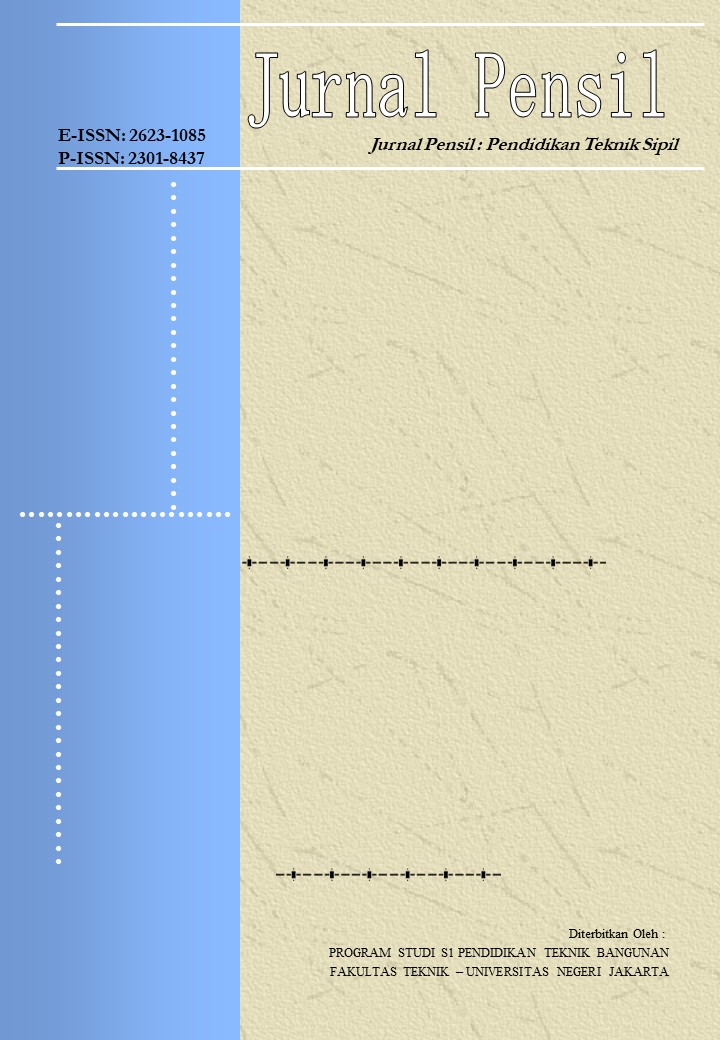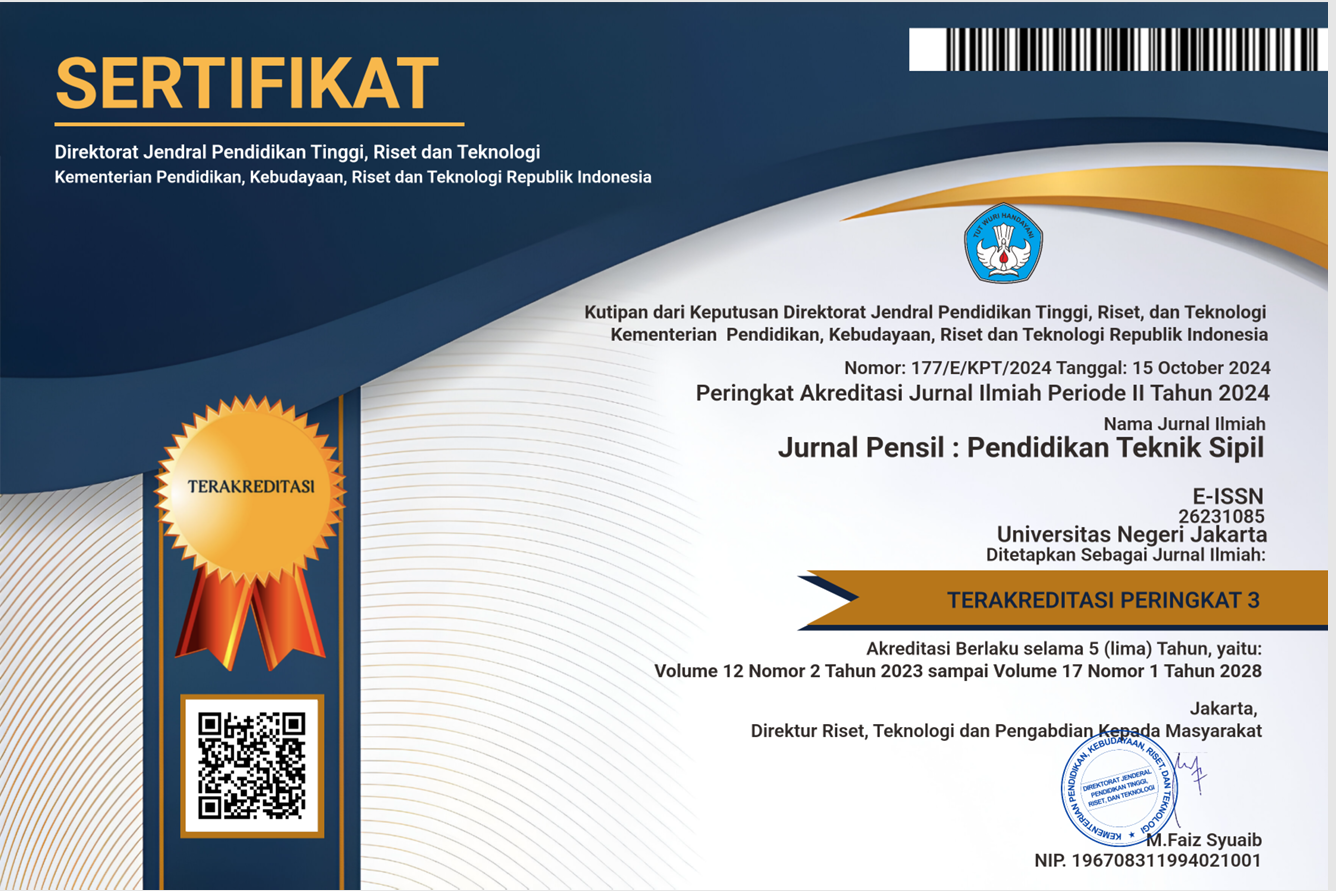COMPOSITION OF CHEMICAL INGREDIENTS IN SUGARCANE BAGASSE ASH WITH VARIATION OF FINAL CALCINATION TEMPERATURE
DOI:
https://doi.org/10.21009/jpensil.v12i2.34855Keywords:
Sugarcane Bagasse Ash, Cement, SEM-EDSAbstract
Cement production worldwide contributes at least a 9% increase in CO2 emissions. Industrial or agricultural waste can cause serious problems for the environment. One of the wastes that can be used as SCM from agricultural waste is sugar cane. This research was conducted to determine the content of chemical elements contained in bagasse ash which is suspected to have chemical content similarities with cement. This study uses an experimental method, with the type of pre-experiment research which has a one shot study case type research scheme. The results indicated that bagasse ash with a final combustion temperature of 600C had the highest silicon content compared to bagasse ash with a final firing temperature of 500C and 700C. The analysis results indicate that with a relatively high percentage of silicon, bagasse ash with a combustion temperature of 600C can be used as an additive or cement substitute.
References
Aprianti, E., Shafigh, P., Bahri, S., & Farahani, J. N. (2015). Supplementary cementitious materials origin from agricultural wastes - A review. Construction and Building Materials, 74, 176–187. https://doi.org/10.1016/j.conbuildmat.2014.10.010
Badan Standar Nasional. (2004). SNI 15-2049-2004: Semen Portland. Badan Standar Nasional.
Bahurudeen, A., & Santhanam, M. (2015). Influence of different processing methods on the pozzolanic performance of sugarcane bagasse ash. Cement and Concrete Composites, 56, 32–45. https://doi.org/10.1016/j.cemconcomp.2014.11.002
Batool, F., Masood, A., & Ali, M. (2020). Characterization of Sugarcane Bagasse Ash as Pozzolan and Influence on Concrete Properties. Arabian Journal for Science and Engineering, 45(5), 3891–3900. https://doi.org/10.1007/s13369-019-04301-y
Berenguer, R. A., Capraro, A. P. B., Farias de Medeiros, M. H., Carneiro, A. M. P., & de Oliveira, R. A. (2020). Sugar cane bagasse ash as a partial substitute of Portland cement: Effect on mechanical properties and emission of carbon dioxide. Journal of Environmental Chemical Engineering, 8(2). https://doi.org/10.1016/j.jece.2020.103655
Bhargavi, P., & Murali, K. (2018). An experimental study on partial replacement of cement with bagasse ASH in concrete mix. Int. J. Civ. Eng. Technol, 9, 175–184.
British Standards Institution. (2011). BS EN 197-1:2011. Cement - Composition, specifications, and conformity criteria for common cements. British Standards Institution.
Chusilp, N., Jaturapitakkul, C., & Kiattikomol, K. (2009). Utilization of bagasse ash as a pozzolanic material in concrete. Construction and Building Materials, 23(11), 3352–3358. https://doi.org/10.1016/j.conbuildmat.2009.06.030
Cordeiro, G. C., & Kurtis, K. E. (2017). Effect of mechanical processing on sugar cane bagasse ash pozzolanicity. Cement and Concrete Research, 97, 41–49. https://doi.org/10.1016/j.cemconres.2017.03.008
Cordeiro, G. C., Toledo Filho, R. D., & Fairbairn, E. M. R. (2009). Effect of calcination temperature on the pozzolanic activity of sugar cane bagasse ash. Construction and Building Materials, 23(10), 3301–3303. https://doi.org/10.1016/j.conbuildmat.2009.02.013
Cordeiro, G. C., Toledo Filho, R. D., Tavares, L. M., & Fairbairn, E. M. R. (2008). Pozzolanic activity and filler effect of sugar cane bagasse ash in Portland cement and lime mortars. Cement and Concrete Composites, 30(5), 410–418. https://doi.org/10.1016/j.cemconcomp.2008.01.001
Deepika, S., Anand, G., Bahurudeen, A., & Santhanam, M. (2017). Construction Products with Sugarcane Bagasse Ash Binder. Journal of Materials in Civil Engineering, 29(10), 4017189. https://doi.org/10.1061/(ASCE)MT.1943-5533.0001999
Direktorat Jenderal Bina Konstruksi. (2023). Profil Material Semen. SIMPK. https://simpk.pu.go.id/material/profil/semen
Direktorat Jenderal Perkebunan. (2022). Statistik Perkebunan Unggulan Nasional 2020 - 2022.
Embong, R., Shafiq, N., Kusbiantoro, A., & Nuruddin, M. F. (2016). Effectiveness of low-concentration acid and solar drying as pre-treatment features for producing pozzolanic sugarcane bagasse ash. Journal of Cleaner Production, 112, 953–962. https://doi.org/https://doi.org/10.1016/j.jclepro.2015.09.066
Fairbairn, E. M. R., Americano, B. B., Cordeiro, G. C., Paula, T. P., Toledo Filho, R. D., & Silvoso, M. M. (2010). Cement replacement by sugar cane bagasse ash: CO2 emissions reduction and potential for carbon credits. Journal of Environmental Management, 91(9), 1864–1871. https://doi.org/10.1016/j.jenvman.2010.04.008
Frías, M., Villar, E., & Savastano, H. (2011). Brazilian sugar cane bagasse ashes from the cogeneration industry as active pozzolans for cement manufacture. Cement and Concrete Composites, 33(4), 490–496. https://doi.org/10.1016/j.cemconcomp.2011.02.003
Gar, P. S., Suresh, N., & Bindiganavile, V. (2017). Sugar cane bagasse ash as a pozzolanic admixture in concrete for resistance to sustained elevated temperatures. Construction and Building Materials, 153, 929–936.
Jahanzaib Khalil, M., Aslam, M., & Ahmad, S. (2021). Utilization of sugarcane bagasse ash as cement replacement for the production of sustainable concrete – A review. In Construction and Building Materials (Vol. 270). Elsevier Ltd. https://doi.org/10.1016/j.conbuildmat.2020.121371
Jamora, J. B., Gudia, S. E. L., Go, A. W., Giduquio, M. B., Orilla, J. W. A., & Loretero, M. E. (2019). Potential reduction of greenhouse gas emission through the use of sugarcane ash in cement-based industries: A case in the Philippines. Journal of Cleaner Production, 239, 118072. https://doi.org/10.1016/j.jclepro.2019.118072
Joshaghani, A., & Moeini, M. A. (2017). Evaluating the effects of sugar cane bagasse ash (SCBA) and nanosilica on the mechanical and durability properties of mortar. Construction and Building Materials, 152, 818–831. https://doi.org/https://doi.org/10.1016/j.conbuildmat.2017.07.041
Katare, V. D., & Madurwar, M. V. (2017). Experimental characterization of sugarcane biomass ash – A review. Construction and Building Materials, 152, 1–15. https://doi.org/10.1016/j.conbuildmat.2017.06.142
Kazmi, S. M. S., Munir, M. J., Patnaikuni, I., & Wu, Y.-F. (2017). Pozzolanic reaction of sugarcane bagasse ash and its role in controlling alkali silica reaction. Construction and Building Materials, 148, 231–240. https://doi.org/https://doi.org/10.1016/j.conbuildmat.2017.05.025
Kementerian Pekerjaan Umum dan Perumahan Rakyat. (2022). Informasi Statistik Infrastruktur PUPR 2022.
Kolawole, J. T., Babafemi, A. J., Fanijo, E., Chandra Paul, S., & Combrinck, R. (2021). State-of-the-art review on the use of sugarcane bagasse ash in cementitious materials. Cement and Concrete Composites, 118(September 2020), 103975. https://doi.org/10.1016/j.cemconcomp.2021.103975
Lyra, G. P., Borrachero, M. V., Soriano, L., Payá, J., & Rossignolo, J. A. (2021). Comparison of original and washed pure sugar cane bagasse ashes as supplementary cementing materials. Construction and Building Materials, 272, 122001. https://doi.org/10.1016/j.conbuildmat.2020.122001
Mangi, S. A., Jamaluddin, N., Wan Ibrahim, M. H., Abdullah, A. H., Abdul Awal, A. S. M., Sohu, S., & Ali, N. (2017). Utilization of sugarcane bagasse ash in concrete as partial replacement of cement. IOP Conference Series: Materials Science and Engineering, 271(1). https://doi.org/10.1088/1757-899X/271/1/012001
Miller, S. A., John, V. M., Pacca, S. A., & Horvath, A. (2018). Carbon dioxide reduction potential in the global cement industry by 2050. Cement and Concrete Research, 114(August), 115–124. https://doi.org/10.1016/j.cemconres.2017.08.026
Minnu, S. N., Bahurudeen, A., & Athira, G. (2021). Comparison of sugarcane bagasse ash with fly ash and slag: An approach towards industrial acceptance of sugar industry waste in cleaner production of cement. Journal of Cleaner Production, 285, 124836. https://doi.org/https://doi.org/10.1016/j.jclepro.2020.124836
Moumin, G., Ryssel, M., Zhao, L., Markewitz, P., Sattler, C., Robinius, M., & Stolten, D. (2020). CO2 emission reduction in the cement industry by using a solar calciner. Renewable Energy, 145, 1578–1596. https://doi.org/10.1016/j.renene.2019.07.045
Panesar, D. K., & Zhang, R. (2020). Performance comparison of cement replacing materials in concrete: Limestone fillers and supplementary cementing materials – A review. Construction and Building Materials, 251, 118866. https://doi.org/https://doi.org/10.1016/j.conbuildmat.2020.118866
Rossignolo, J. A., Rodrigues, M. S., Frias, M., Santos, S. F., & Junior, H. S. (2017). Improved interfacial transition zone between aggregate-cementitious matrix by addition sugarcane industrial ash. Cement and Concrete Composites, 80, 157–167. https://doi.org/https://doi.org/10.1016/j.cemconcomp.2017.03.011
Shafiq, N., Hussein, A. A. E., Nuruddin, M. F., & Al Mattarneh, H. (2016). Effects of sugarcane bagasse ash on the properties of concrete. Proceedings of the Institution of Civil Engineers-Engineering Sustainability, 171(3), 123–132.
Soares, M. M. N. S., Poggiali, F. S. J., Bezerra, A. C. S., Figueiredo, R. B., Aguilar, M. T. P., & Cetlin, P. R. (2014). The effect of calcination conditions on the physical and chemical characteristics of sugar cane bagasse ash. In Rem: Revista Escola de Minas (Vol. 67). scielo .
Subedi, S., Arce, G., Hassan, M., Kumar, N., Barbato, M., & Gutierrez-Wing, M. T. (2019). Influence of Production Methodology on the Pozzolanic Activity of Sugarcane Bagasse Ash. MATEC Web of Conferences, 271, 07003. https://doi.org/10.1051/matecconf/201927107003
Suliman, M., & Almola, S. (2011). The use of sugarcane bagasse ash as an alternative local pozzolanic material: study of chemical composition. Science Vision, 16(17), 65–70.
Xu, Q., Ji, T., Gao, S.-J., Yang, Z., & Wu, N. (2018). Characteristics and applications of sugar cane bagasse ash waste in cementitious materials. Materials, 12(1), 39.
Yadav, A. L., Sairam, V., Muruganandam, L., & Srinivasan, K. (2020). An overview of the influences of mechanical and chemical processing on sugarcane bagasse ash characterisation as a supplementary cementitious material. Journal of Cleaner Production, 245, 118854. https://doi.org/https://doi.org/10.1016/j.jclepro.2019.118854
Zareei, S. A., Ameri, F., & Bahrami, N. (2018). Microstructure, strength, and durability of eco-friendly concretes containing sugarcane bagasse ash. Construction and Building Materials, 184, 258–268. https://doi.org/10.1016/j.conbuildmat.2018.06.153











.png)
.png)
1.png)

